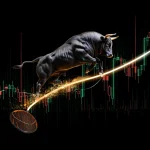Prediction and Paradox: The Double-Edged Sword of Financial Foresight
May 1, 2025
“In the theatre of markets, prediction is both prophecy and performance—a high-wire act where the line between foresight and folly is gossamer-thin.”
In the shadow of global monetary tremors and the relentless churn of financial innovation, few voices resonate with the provocative force of Max Keiser. Renowned broadcaster, former Wall Street trader, and early Bitcoin evangelist, Keiser has built his reputation on the knife-edge between prediction and provocation. As central banks conjure liquidity and inflation ghosts haunt the world’s economies, Keiser’s incendiary forecasts—particularly his Bitcoin prophecies—demand attention. Is Max Keiser a modern Cassandra, fated to see what others miss, or does his vision blur at the boundaries of ideology and spectacle? This article delves deep into the paradoxes, triumphs, and pitfalls of Keiser’s predictions, seeking to illuminate the gold—and the dross—in his economic worldview.
The Alchemist’s Paradox: Paper Money, Hard Gold, and Digital Scarcity
Max Keiser’s economic philosophy is a collision of old world and new. He has railed against the “alchemy” of fiat currencies, likening central bank policy to a medieval experiment gone wrong—one where lead is never truly transmuted into gold, but instead leaves a toxic residue of debt and moral hazard. In Keiser’s worldview, modern monetary theory is less a revolution than a conjurer’s trick: sovereign currencies, unmoored from intrinsic value, breed bubbles and erode trust.
Yet Keiser’s solution is both ancient and radical. For him, gold remains the eternal standard—a “hard” asset immune to mankind’s penchant for monetary mischief. But Keiser’s genius, or heresy, lies in his leap from gold’s physical scarcity to Bitcoin’s digital scarcity. Here, he invokes a paradox: Bitcoin, a creation of pure code, is—he argues—more real than the paper money that governments print at will. “Gold is God’s money,” Keiser has pronounced, “Bitcoin is the currency of math.” The contradiction is deliberate: gold as anchor, Bitcoin as lifeboat. His dual advocacy pits him against both inflationists and technophobes, making his stance as much a philosophical rebellion as a financial one.
Technical Prophecies: Tools of the Seer
Keiser’s method is an alchemy of technical analysis, macroeconomic insight, and media showmanship. On his long-running “Keiser Report,” he dissects charts, tracks flows, and deploys a lexicon that fuses streetwise trading with economic theory. For Bitcoin, he has invoked the stock-to-flow model popularised by PlanB, arguing that digital scarcity will inexorably drive price upward as each halving epoch tightens supply.
But Keiser’s toolkit is not limited to technicals. He is a student of global finance, chronicling the debasement of currencies from the pound’s 20th-century decline to the yen’s recent woes. He wields historical analogy as a scalpel: likening Bitcoin’s rise to the post-Bretton Woods gold rally, or warning of “hyperbitcoinisation” as the new Weimar moment. His predictions are couched in the language of revolution—he does not merely forecast, he proselytises. This blend of technical rigour and rhetorical fire has made Keiser a lightning rod: to some, an oracle; to others, a market performer.
The Golden Thread: Triumphs and Failures in Prediction
Keiser’s most celebrated prophecy is, without doubt, his early and unwavering advocacy for Bitcoin. In 2011, when the digital currency languished below $5, he called for “$100,000 and beyond.” As of 2025, Bitcoin has breached $70,000, and while the six-figure prophecy remains just out of reach, Keiser’s call is among the most prescient of the decade. He has consistently championed gold as a hedge against fiat implosion, a view vindicated during every bout of quantitative easing and inflationary panic.
Yet, the golden thread is not without its knots. Keiser’s timeline for “hyperbitcoinisation”—a scenario where Bitcoin supplants fiat as global reserve—has often proven slippery. His warnings of imminent dollar collapse have, so far, been premature. His predictions regarding the demise of the euro, or a mass exodus from sovereign bonds, have not materialised at the scale or speed he envisioned. The paradox here is instructive: Keiser’s vision often captures the broad arc of monetary transformation, but his timing—like all prophets—is vulnerable to the uncertainties of history.
Edge Cases and Outliers: The Rebel’s Theories
Keiser thrives in the domain of the outlier. He has backed not only Bitcoin but a panoply of “hard” assets and decentralised technologies, arguing that the next wave of financial evolution will be shaped by those who refuse to play by the old rules. His support for privacy coins, decentralised exchanges, and even meme tokens has often raised eyebrows among traditionalists.
Perhaps most famously, Keiser warned of a “hash war” between nation-states, predicting that countries would one day scramble to secure Bitcoin mining power as a strategic asset. In 2019, he foresaw El Salvador’s Bitcoin adoption, years before it stunned the world by making Bitcoin legal tender. Keiser’s penchant for edge-case thinking—embracing scenarios that conventional analysts dismiss as improbable—has both amplified his influence and exposed him to ridicule. Yet, in the nonlinear world of markets, it is precisely at these edges that the next paradigm shift often emerges.
Philosophical Foundations: The Deeper Implications
At the root of Keiser’s worldview is a profound distrust of centralised authority, and a conviction that monetary freedom is inseparable from human freedom. He invokes philosophy as much as finance: likening Bitcoin to the “separation of money and state”—a Copernican revolution in economic thought. For Keiser, every currency crisis or bailout is not merely a technical failure, but a moral one—a breach of trust between rulers and the ruled.
His broadcast style is Socratic, often challenging guests and viewers to question the very nature of value, trust, and sovereignty. He draws on metaphors from mythology (Prometheus unchained, Pandora’s box) and contemporary culture (the Matrix, the Red Pill) to dramatise financial awakening. In this sense, Keiser is as much a storyteller as an analyst—his predictions serve as parables, warning and awakening in equal measure.
Final Synthesis: Weighing Prophecy and Performance
Max Keiser’s legacy in financial discourse is that of a paradoxical seer: often right in essence, sometimes errant in detail, but never lacking in conviction. His greatest contribution may be the way he has reframed the debate on money, forcing mainstream analysts to contend with Bitcoin, gold, and the spectre of fiat collapse. In a world awash in liquidity and uncertainty, Keiser’s clarion calls for hard assets and decentralised systems echo with increasing relevance.
Yet, his penchant for drama sometimes overshadows his deeper insights. The line between urgent warning and perpetual alarm can blur, leaving followers to sift gold from pyrite. But in an age where consensus is often the enemy of truth, Keiser’s willingness to challenge orthodoxy is invaluable. Whether you see him as oracle or outlier, his voice remains essential in the cacophony of financial prediction.
Keiser’s Market Prophecies: Golden Insights or Fool’s Gold?
| Prediction | Outcome | Verdict |
|---|---|---|
| Bitcoin to $100,000 by 2022 | Peaked near $69,000 in 2021; not yet reached six figures | Directionally correct, timing ambitious |
| Gold as safe haven during global crises | Gold surged during COVID-19 and geopolitical shocks | Confirmed |
| US Dollar collapse imminent | Dollar remains global reserve, but inflation has eroded purchasing power | Premature, partially validated |
| El Salvador to adopt Bitcoin as legal tender | El Salvador did so in 2021, shocking global markets | Remarkably accurate |
| Nation-states to compete for Bitcoin mining dominance | US, China, and Russia in visible competition for mining hash rate | Emerging trend |
| Collapse of the Eurozone | Eurozone still intact amid recurring crises | Unrealised |
How He Missed: Analysing Keiser’s Prediction Failures
- Overzealous Timelines: Max Keiser’s predictions often carry a sense of urgency that reality does not always match. His calls for imminent dollar collapse or Bitcoin’s rapid ascent to $100,000 by 2022 were compelling, but the market’s timeline proved more patient and complex. The exuberance of his forecasts sometimes overshadows the slow-grinding gears of global finance.
- Binary Framing of Outcomes: Keiser tends to frame outcomes in stark, binary terms—hyperinflation or bust, fiat collapse or Bitcoin supremacy. While this makes for riveting television and a clear message, the real world often delivers shades of grey. The endurance of the euro, the resilience of US Treasuries, and the continued role of central banks all defy his more absolute scenarios.
- Underestimating Institutional Adaptability: Keiser’s narrative has sometimes underestimated the ability of governments and financial institutions to adapt and reassert control. Central banks have repeatedly found new ways to stabilise markets and delay fiat reckoning, using tools that even seasoned critics did not foresee.
- Selective Spotlighting: While many of his boldest predictions have rightly earned headlines, several missed calls—such as repeated warnings of imminent eurozone breakup or false starts for gold’s “moonshot”—have faded into the background. This selective memory, common among market pundits, can distort the perceived accuracy of his forecasting record.
Final Conclusion: The Paradox of the Modern Oracle
Max Keiser’s journey as a financial prophet is a study in paradox. He is both the alarm bell and the siren song, a voice that stirs both anxiety and aspiration. His greatest strength lies in his ability to frame the monetary debate in vivid, memorable terms—Bitcoin as “digital gold,” fiat as “paper fraud,” gold as the “eternal refuge.” Yet, this same gift can sometimes verge on dogma, blurring the boundary between urgent insight and relentless hype.
Nevertheless, to dismiss Keiser as a mere provocateur is to miss the deeper current beneath his rhetoric. His early embrace of Bitcoin, his warnings about systemic fragility, and his advocacy for decentralised finance have all entered the mainstream lexicon. He forces the financial world to confront uncomfortable truths: that trust in money is fragile, that monetary authority can abuse its power, and that technological innovation can upend centuries-old paradigms.
The legacy of Max Keiser—like markets themselves—is not a straight line but a braided river, full of unexpected turns, dry spells, and sudden floods. He is a modern oracle whose voice, whether you agree or dissent, cannot be ignored. In the theatre of prediction, he reminds us that the future is always a contested frontier, and that the real gold often lies at the edges of accepted wisdom.













